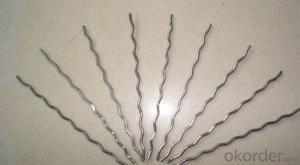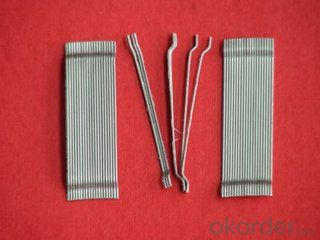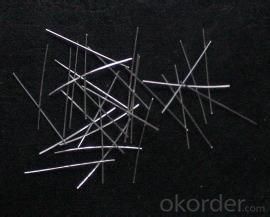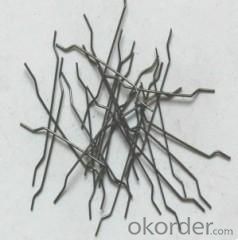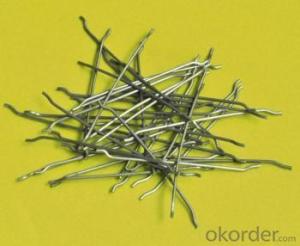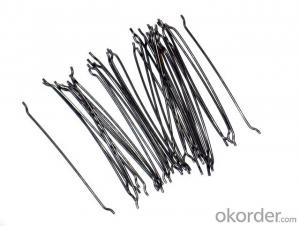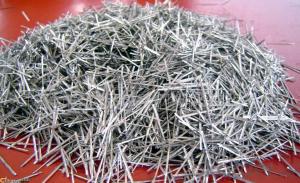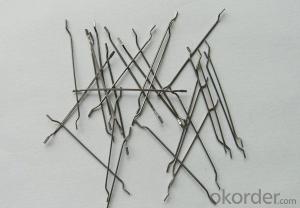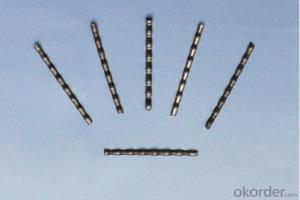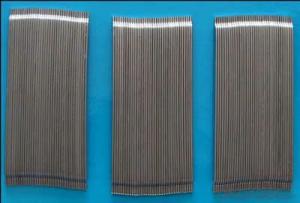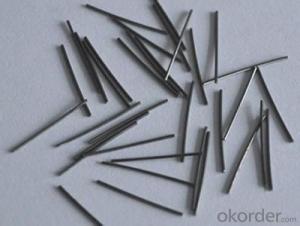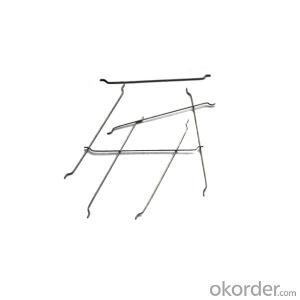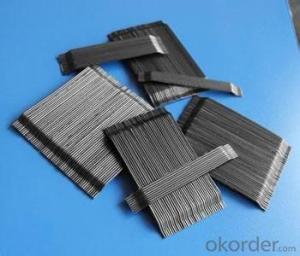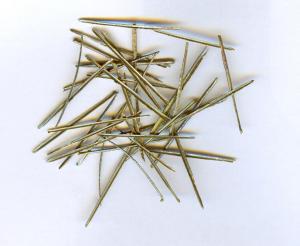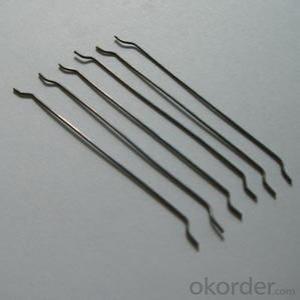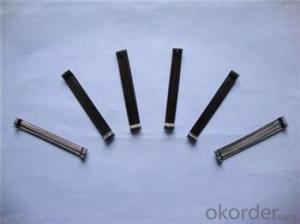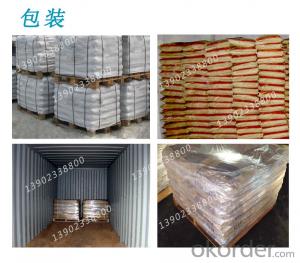Melt Extract Stainless Steel Fiber Reinforced Stainless for Good Concrete Admixtures
- Loading Port:
- Tianjin
- Payment Terms:
- TT OR LC
- Min Order Qty:
- 2000 kg
- Supply Capability:
- 250000 kg/month
OKorder Service Pledge
OKorder Financial Service
You Might Also Like
Quick Details
Place of Origin: Hebei, China (Mainland)
Model Number: CW04
Material: Steel
Material:: Steel,low carbon steel wire
Standard:: ASTM ,ISO9001,CE
Shape:: hooked ends and straight middle
Grade:: Q195
Application:: shortcrete on tunnel, underground project, dam plate
Tensile strength:: 1100MPA to 2850Mpa
Demension:: per your requirement
Place of Origin:: HeBei China (Mainland)
Delivery Detail:: in 7 days upon receive prepayment
Product features
with excellent tensile ,hightenacity ,against cracking and fatigue ,they`re widely usd in the structures made of concrete 50X1.0 mm cold drawn stainless steel fiber with 1200 Mpa, used for production of reinforced concrete Stainless steel fiber with high tensile strength is ideal for reinforcing concrete. High quality cold drawn steel fiber improves concrete's resistance and allows to use thinner layer of concrete, reducing construction costs.Fiber can be manufactured as per customer's specifications. Please enquire for a price quotaton based on your requirements FOB Saint Petersburg price is available upon request.
Specifications
1.hooked steel fiber
2.CE and ISO9001:2008
3.diameter from 0.5mm to 1.2mm
4.competitive price,high quality and service
Hooked Steel Fiber:
1.Diameter:0.5mm-1.0mm
2.Length: 25mm-60mm
3.Material: low carbon steel wire
4.Feature: excellent tensile,high tenacity,against cracking,impact and fatigue
5.Uses: high way,tunnel,building,airport road serface and so on .
Picture
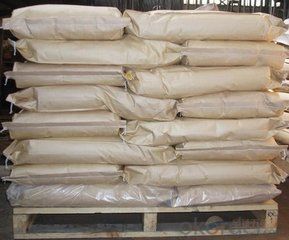
FOB Saint Petersburg price is available upon request
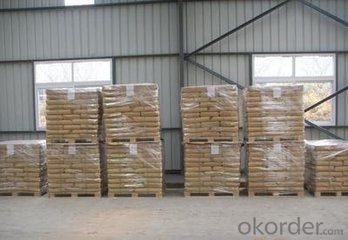
good quality and competitive price
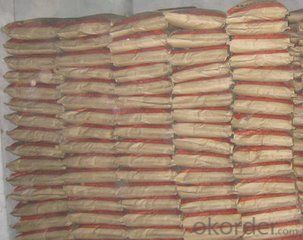
steel fiber concrete reinforced
FAQ
astm a820 steel fiber,carbon steel fibers
we can produce any type steel fiber and of course we can make production according to your requirement
we have specilize in this field for almost 10 years ,with good quality and competitive price
- Q: What is the typical fiber length of melt extract stainless steel fiber?
- The typical fiber length of melt extract stainless steel fiber can vary depending on the specific product and manufacturer. However, on average, melt extract stainless steel fibers typically have a fiber length ranging from 3 mm to 25 mm. This length is suitable for various applications, such as reinforcement of concrete and other composite materials, thermal insulation, and electromagnetic shielding. It is important to note that different industries and uses may have specific requirements for fiber length, so it is always recommended to consult the manufacturer or supplier for the exact specifications needed for a particular project.
- Q: What is the recommended mix design for concrete containing melt extract stainless steel fiber?
- The recommended mix design for concrete containing melt extract stainless steel fiber typically involves using a higher dosage of fibers compared to traditional concrete mix designs. This is because stainless steel fibers have a higher aspect ratio and better tensile strength, which allows for better reinforcement and crack resistance in the concrete. The fiber dosage can vary depending on the specific application and desired performance characteristics of the concrete. However, a general guideline is to use between 1% to 2% by volume of stainless steel fibers. This dosage range has been found to provide optimal reinforcement and improve the overall durability of the concrete. In addition to the fiber dosage, it is important to consider other factors such as the water-cement ratio, aggregate gradation, and admixture selection. The water-cement ratio should be carefully controlled to ensure the mix is workable and has adequate strength. The aggregate gradation should be optimized to provide a dense and strong concrete matrix. Admixtures can also be used to improve the workability, pumpability, and setting time of the concrete. It is recommended to consult with a qualified engineer or concrete supplier to determine the specific mix design parameters for a project involving melt extract stainless steel fiber. Overall, the recommended mix design for concrete containing melt extract stainless steel fiber involves a higher fiber dosage, careful control of water-cement ratio, optimization of aggregate gradation, and appropriate use of admixtures. This will help ensure a high-performance concrete with improved reinforcement and durability properties.
- Q: Can melt extract stainless steel fiber be used in architectural concrete?
- Indeed, melt extract stainless steel fiber is a viable option for incorporating into architectural concrete. Its utilization is widespread in architectural concrete projects owing to its impressive strength and durability. By reinforcing the concrete, it aids in bolstering its resistance against cracking, shrinkage, and impact, thereby augmenting the overall performance and lifespan of the structures. Moreover, the inclusion of melt extract stainless steel fiber in architectural concrete also fortifies its resistance against corrosion, rendering it suitable for implementation in architectural endeavors that face exposure to harsh environmental conditions. In summary, the integration of melt extract stainless steel fiber into architectural concrete not only enhances its structural integrity but also elevates its aesthetic allure.
- Q: Can melt extract stainless steel fiber be used in refractory applications?
- Melt extract stainless steel fiber can absolutely be utilized in refractory applications. Renowned for their exceptional mechanical properties and resistance to high temperatures, stainless steel fibers prove themselves as suitable candidates for inclusion in refractory materials. By incorporating these fibers, the strength, thermal shock resistance, and overall performance of refractory products can be significantly improved. They are widely applied in various scenarios, including furnace linings, kiln furniture, and thermal insulation. The melt extract process guarantees a consistent composition and structure of the stainless steel fibers, thereby enhancing their performance and durability in high-temperature environments. In summary, melt extract stainless steel fiber serves as a valuable addition to refractory materials, offering enhanced thermal and mechanical properties.
- Q: What is the role of melt extract stainless steel fiber in refractory materials?
- The primary function of melt extract stainless steel fiber in refractory materials is to enhance their mechanical properties and performance. By adding stainless steel fibers to the refractory mix, reinforcement is provided and the material's resistance to thermal shock, cracking, and mechanical stress is improved. The melt extract process ensures that the stainless steel fibers possess a high level of purity and uniformity, rendering them suitable for high-temperature applications. Though added in small quantities, these fibers significantly enhance the refractory mix's strength, toughness, and resistance to wear and erosion. In addition, stainless steel fibers augment the refractory material's thermal conductivity and dimensional stability, enabling it to endure extreme temperatures without experiencing substantial deformation or deterioration. They establish a reinforcement network within the refractory matrix, preventing the spread of cracks and bolstering its overall durability. Moreover, stainless steel fibers can reinforce the refractory material's resistance to chemical attack and corrosion, making it appropriate for usage in aggressive environments. They can also improve the refractory's ability to retain heat, thereby enhancing energy efficiency in various industrial applications. In conclusion, the incorporation of melt extract stainless steel fibers into refractory materials significantly enhances their mechanical strength, thermal stability, and resistance to different forms of deterioration. This equips refractory materials to withstand challenging operating conditions and extend their lifespan, making them indispensable in industries like steelmaking, cement production, glass manufacturing, and petrochemical processing.
- Q: Can melt extract stainless steel fiber be used in sound barrier walls?
- Indeed, sound barrier walls can utilize melt extract stainless steel fiber. Given their exceptional acoustic properties and robustness, stainless steel fibers find frequent use in soundproofing scenarios. By absorbing and attenuating sound waves proficiently, these fibers effectively decrease noise transmission through the barrier walls. Moreover, their remarkable durability and resistance to corrosion render them well-suited for outdoor applications. In summary, incorporating melt extract stainless steel fiber in sound barrier walls can bolster their soundproofing potential and enhance the structure's overall acoustic performance.
- Q: What is the mechanism of steel fiber spacing enhancement?
- Through the analysis of composite theory and steel fiber spacing theory, it is proved that stainless steel fiber has the potential of higher resistance to cracking, and its tensile strength is improved remarkably,
- Q: How does melt extract stainless steel fiber improve the resistance to chemical attack in concrete?
- Melt extract stainless steel fiber improves the resistance to chemical attack in concrete by providing a protective barrier against corrosive substances. The stainless steel fibers act as a reinforcement in the concrete matrix, enhancing its durability and preventing chemical agents from penetrating and deteriorating the concrete structure.
- Q: What is the typical aspect ratio of melt extract stainless steel fiber?
- The typical aspect ratio of melt extract stainless steel fiber is around 50:1 to 100:1. Aspect ratio refers to the length-to-diameter ratio of the fiber. In the case of melt extract stainless steel fiber, the length is typically 50 to 100 times greater than its diameter. This elongated shape helps enhance the mechanical properties and performance of the fiber in various applications such as reinforcement in composites, thermal management, and electromagnetic shielding.
- Q: Does melt extract stainless steel fiber have any adverse effects on the workability of concrete?
- No, melt extract stainless steel fiber does not have any adverse effects on the workability of concrete. In fact, it can enhance the workability and improve the overall performance of the concrete mixture. Stainless steel fibers are typically added to concrete to provide reinforcement and improve its durability, impact resistance, and crack control properties. The addition of stainless steel fibers can improve the flow and workability of concrete, making it easier to handle and place during construction. These fibers act as a reinforcement and help to distribute applied loads more evenly throughout the concrete matrix, reducing the risk of cracking and improving its structural integrity. Furthermore, stainless steel fibers also offer excellent corrosion resistance, ensuring the long-term durability of the concrete. This is particularly beneficial in environments where the concrete is exposed to harsh conditions or chemicals that could potentially degrade the material. Overall, the incorporation of melt extract stainless steel fibers in concrete does not have any adverse effects on its workability. Instead, it enhances the concrete's performance, making it more durable, crack-resistant, and easier to work with during construction.
Send your message to us
Melt Extract Stainless Steel Fiber Reinforced Stainless for Good Concrete Admixtures
- Loading Port:
- Tianjin
- Payment Terms:
- TT OR LC
- Min Order Qty:
- 2000 kg
- Supply Capability:
- 250000 kg/month
OKorder Service Pledge
OKorder Financial Service
Similar products
Hot products
Hot Searches
Related keywords
